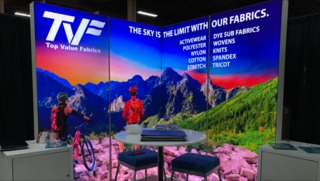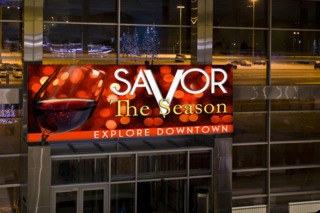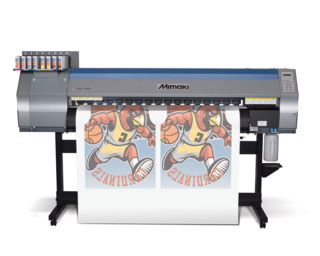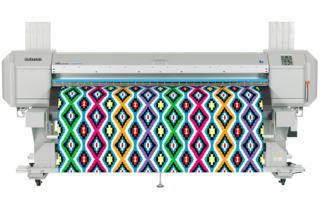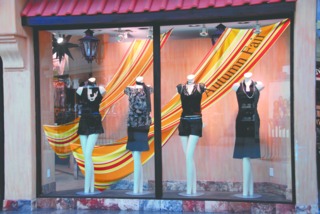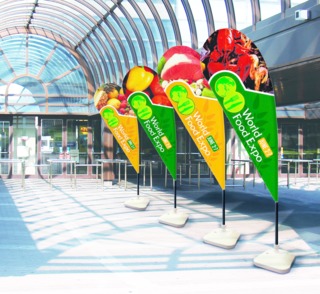Sensational Soft Signage—Tapping One of Fabric’s Fast-Growing Niches
Soft signage is in high demand–and, new, more advanced printers, inks, and media are making it easier and more profitable.

From the stadium and convention hall to the airport and that high-end retailer, soft signage is popping up across the consumer landscape.
In fact, Smithers Pira research estimates that digital textile printing market volume is increasing at an annual rate of 17.5% from 2016 to 2021, and that it will reach a market value of more than $2 billion in this timeframe.
According to Mike Wozny, senior product manager for EFI, soft signage represents one of the market’s best growth opportunities for print service providers (PSPs).
“This time two years ago, industry estimates were around 6 to 8% growth for the soft signage market,” he said. “Now we are experiencing double-digit growth. It has been a very good market, and it is even better today.”
Mike Compton, product marketing manager, print media for Top Value Fabrics Media, says his company is witnessing this trend as well. “The market is absolutely exploding with growth, and we continue to find new avenues for soft signage,” he said.
According to Tommy Martin, product manager, textiles & apparel business development and marketing for Mimaki USA, soft signage dominated exhibit displays at the recent SGIA show. “The vast majority of overhead signage was fabric,” he said.
Fabric’s unique advantages
So, what is it about fabric that is making it today’s go-to media for signage?
“A lot of it has to do with environmental regulations and sustainability,” said Lily Hunter, product manager, textiles and consumable supplies for Roland DGA Corp. “A lot of brands want their stores and products to be sustainable.”
Wozny attributes fabric’s cache to its upscale look. “Vinyl has been around for 20 to 30 years,” he said. “Fabric looks different – it looks better, and higher-end brands are aligned with this.”
Plus, using fabric for signage simplifies logistics, adds Tom Wittenberg, large-format segment marketing manager, sign & décor, the Americas for HP. “It is much lighter and less expensive to ship than materials that are bigger and bulkier,” he said.
Randy Anderson, product marketing manager for Mutoh Americas Inc., agrees. “The top application for soft signage is in the trade show arena, and the nature of the trade show—for example, storing signage from the last show—lends itself well to polyester fabrics which can be wadded up, thrown in a box, unfolded, and steamed to look like new,” he said. “This is something you can’t do with vinyl.”
It’s also highly versatile, emphasizes Hunter. “Fabric works well for standard signage and banners, and it drapes nicely as a backdrop for retailers,” she said.
While fabric has many signage applications, where it really shines today, says Compton, is for backlits.
“Fabric backlits are huge for retail P.O.P. displays and trade shows,” he said. “The major department stores and chains use fabric for backlits because it is easy to switch out seasonally and for promotions. We are also seeing more fabric backlits in transportation venues such as airports and train stations.”
Getting started
To make the most of the market opportunity, Martin advises PSPs to consider what types of soft signage might best serve their existing clientele. “Flags, wind dancers, silicone edge graphics (SEGs), and the likes are all items that fit within a PSP’s offering,” he said.
PSPs should also consider whether their existing equipment can deliver a quality print on fabric—or whether a technological upgrade is needed. While sublimation is the fabric printing process of choice for North American PSPs, Compton sees this dynamic changing.
“In North America, we’ve always been about 10 years behind Europe technologically,” he said. “Today, the U.S. is still 85 to 90 percent sublimation for soft signage, whereas Europe is now 90 percent direct disperse. This is going to shift rapidly.”
This shift, says Wittenberg, is being fueled in part by advances in ink technology. “Today, HP latex inks can be used both on the synthetics that you find going through dye sub machines and on natural fibers like cottons, which differentiates the technology from dye sub,” he said.
And, unlike dye sublimation, Wittenberg notes, many types of latex soft signage can be produced without the added step of heat fixation. “To produce a latex graphic that is washable, you need the printed fabric to be heat calendered,” he said. “But if you are just producing regular signage, such as a backlit, you do not need to do that.”
Wozny adds, “There are technologies today that change the viscosity of water-based inks. This is giving PSPs more mileage out of their inks because there is more color, more pigment—and less water—in every drop. As a result, you can increase your capacity.”
New, advanced media technologies are also making direct-to-fabric printing more viable for shops.
“Media manufacturers are working to find the best coatings and pretreatments to not just accept the inks, but also to add durability,” said Hunter. “If you are printing with an eco-solvent or UV printer today, there are coatings that help with rub-resistance. It is also important to select an anti-wrinkle fabric to avoid any hard creases that cannot be steamed out.”
Bigger, faster, better printers
While new ink and media options are making it easier to work with fabric, so are advances in printing technology.
“Major printer manufacturers are coming out with extremely high-speed printers,” said Compton. “We are also seeing the introduction of 5-meter printers. To produce fabric signage for a football stadium, for example, a 5-meter device simply makes a lot of sense.”
As with any form of signage, fabric signs and displays require finishing. “There’s still a lot of soft signage that is done with SEGs, and you need the right equipment to do that,” said Wittenberg. “Other applications require heat fixation—and others, depending on the materials used, may require a hot knife to prevent frayed edges.”
“PSPs in this market need some sort of cutting device, and lasers are great in terms of volume, quality, and sealing the edge inline,” said Wozny. “Sewing devices are important as well.”
Martin adds, “There are companies that offer finishing/sewing services if the PSP doesn’t want to take that in-house.”
Get educated
Because this market is evolving so rapidly, Wittenberg emphasizes the importance of staying up to date. “As with any application that is new, PSPs really need to understand it well before diving in,” he said.
Compton advises PSPs to choose their vendors strategically. “You should only deal with companies that understand your whole environment and that can help you understand how your systems work together to get the best results for your graphics,” he said.
“Fabric is the future, and the good news for PSPs is that they may be able to start printing fabric on their current printer—and then move into the business at their own pace,” said Hunter.
Wozny adds, “It’s a high-growth, high-margin application that is enabling brands to tell their story. When you tell customers you can do their soft signage, frequently you get other pieces of their campaigns as well. It’s a great complement to the print services shops are already offering.”

